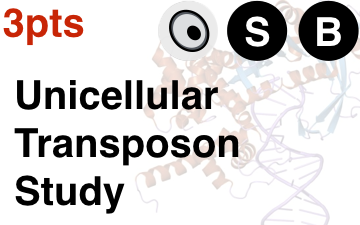A transposable element (TE or transposon) is a DNA sequence that can change its position within a genome, sometimes creating or reversing mutations and altering the cell’s genome size. Transposition often results in duplication of the TE. Barbara McClintock‘s discovery of thesejumping genes earned her a Nobel Prize in 1983.[1]
Transposable elements make up a large fraction of the C-value of eukaryotic cells. There are at least two classes of TEs: Class I TEs generally function via reverse transcription, while Class II TEs encode the protein transposase, which they require for insertion and excision, and some of these TEs also encode other proteins.[2] It has been shown that TEs are important in genome function and evolution.[3] In Oxytricha, which has a unique genetic system, these elements play a critical role in development.[4] Transposons are also very useful to researchers as a means to alter DNA inside a living organism.
(From Wikipedia, June 2016)


